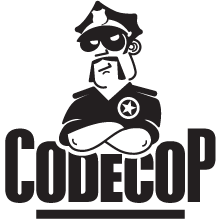 Three weeks ago I attended the eJug Days in Vienna. It was a little conference with some nice presentations. I hadn't been to a conference for some time and was highly motivated. At the end of one particularly cool talk, when the speaker showed his last slide containing the address of his personal web site, a thought hit me. "Man", I thought, "I should have some nice web page with all my stuff put together in one place." This should save my job from going to India ;-) This was the beginning of Code Cop dot org.
Three weeks ago I attended the eJug Days in Vienna. It was a little conference with some nice presentations. I hadn't been to a conference for some time and was highly motivated. At the end of one particularly cool talk, when the speaker showed his last slide containing the address of his personal web site, a thought hit me. "Man", I thought, "I should have some nice web page with all my stuff put together in one place." This should save my job from going to India ;-) This was the beginning of Code Cop dot org.I am a senior developer and have been working with Java and internet related technologies since 1999. And I am a completionist. I like my code being in order, e.g. nicely formatted, readable, proper named, designed, tested etc. In fact I am fanatic about it, sometimes even forced to keep it neat. For example a colleague calls me to his place to discuss some problem and I spot some minor flaw in the code on the screen, e.g. he wrote
static public instead of public static. I'm getting mad. I am unable to listen to him till the flaw is fixed. I can tell you it's a vice. (And rumours are that there are colleagues who write such crap on purpose, just to tease me.) I don't know if it's the impact of my Virgo ascendant or the beginning of some weird mental disorder. But I do know that studying Mathematics and doing research work did not help to be less freaky. I started working on code quality in 2004. While staying with Herold Business Data I was responsible for the code quality of the Online Services, running the Daily Build with Apache Ant and loads of tools. There, after years of harassing my dear colleagues with code and daily build issues, I was officially appointed "Code Cop" in 2006 (and even called a "Code Nazi" once). Later I published some articles about being a Code Cop :-). Now I moved all my QA related stuff from different sources here and will add all things I have not published yet.
I started working on code quality in 2004. While staying with Herold Business Data I was responsible for the code quality of the Online Services, running the Daily Build with Apache Ant and loads of tools. There, after years of harassing my dear colleagues with code and daily build issues, I was officially appointed "Code Cop" in 2006 (and even called a "Code Nazi" once). Later I published some articles about being a Code Cop :-). Now I moved all my QA related stuff from different sources here and will add all things I have not published yet.Like Why the Lucky Stiff I'm an "aspiring author with no true achievements under my belt". I am interested in code quality tools, code generation techniques and recently in dynamic languages like Ruby or Scala. I have a PhD in mathematical computer science (a mixture of Applied Mathematics and Computer Sciences) from the university of technology in Vienna. I live in Austria.
Licence
Scott Hanselman gives advice to license your blog: All the content provided on code-cop.org is Creative Commons Attribution 3.0 licensed (short CC 3.0 BY), except noted otherwise. That says you can share or remix the work as long as you attribute the original work to me. Note that some images might have a different licence. For code I usually use the New BSD License.
Credits
It's time to thank some people for their help: Christoph Kober (Polychrom) for the cool Code Cop logo you see above on the right. Back in grammar school he already made the fanciest drawings. Claudia Gillmeier (Aurian) for her help with the design and layout. Stefan Nestelbacher designed my first T-shirt back in 2006. Further thanks to Douglas Bowman (Minima Stretch template), Mike Samuel (Prettify), phydeaux3 (Tag Cloud) and all the folks at Flickr for releasing their images under the creative commons licence. I just love your images. Keep going! Last but not least I want to thank my significant other Kasia for proofreading and supporting me in setting up this site.








